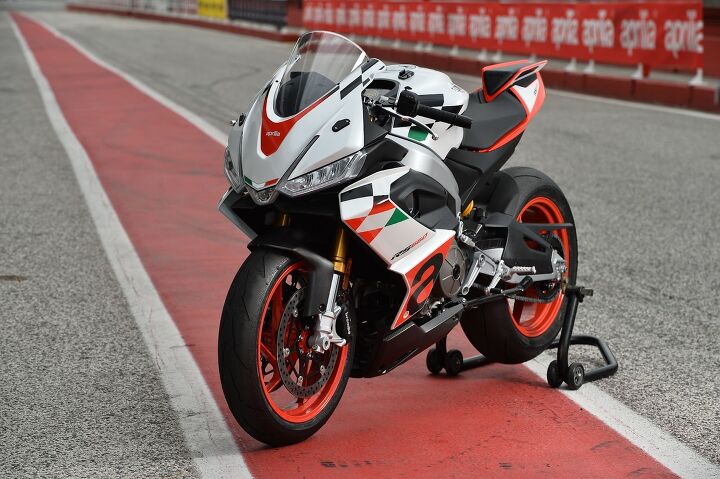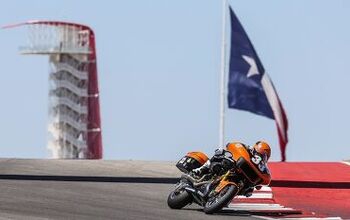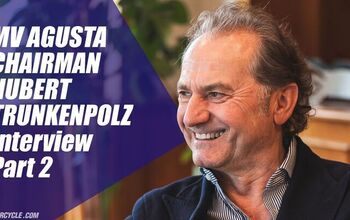2024 Aprilia RS 660 Extrema Review
Track trickster
Aprilia’s measured but inexorable rise to the front of the MotoGP pack in recent months, with two victories in three races plus a Sprint race win, all inside the space of 30 days, has reaffirmed the Piaggio-owned brand’s sporting credentials at the highest level. [Unfortunately for them, this was the extent of Aprilia’s race wins for the year -TS] It’s also served as a parting testimony to the late Roberto Colaninno, Chairman/CEO of Piaggio who passed away on August 19, just days after his 80th birthday and a fortnight after Aleix Espargaró’s Silverstone race victory saw Aprilia turn the tables on its Ducati rivals.
For stock market wheeler-dealer Colaninno deserves credit for taking his eye off the balance sheet long enough to give Aprilia’s race team sufficient budget to elbow aside big spenders Ducati and KTM in a successful drive for MotoGP glory. The Silverstone victory must have given him special satisfaction before passing on to meet his maker.
But even before this, the Noale-based manufacturer’s sporting heritage had already been reinstated this year in its dealer showrooms, too. Ever since its 2021 debut in the marketplace, Aprilia’s RS660 parallel-Twin has been the standout seller in the ever more hotly contested 500-750cc middleweight sector fought over by more than a dozen different manufacturers from East and West. Indeed, the more than 20,000 such motorcycles which company owner Piaggio has so far found owners for in 72 countries around the world since deliveries began in January 2021 make this the current best-selling sportbike globally, outselling anything else with up to twice the engine capacity from Austria, Japan, Germany, Italy and elsewhere.
The arrival of Aprilia’s middleweight twin saw the RS660 draw a new line in the sand for street-legal sportbikes. Costing less than half the price of the same company’s RSV4 1100, in real world terms it’s proved much more accessible than the uber-Superbike it’s distantly derived from. But it’s arguably also just as thrilling to ride, even – or maybe especially – for more experienced riders, for whom the thrill of optimizing braking, maxing out turn speed, and getting harder on the gas that much sooner is in so many ways much more of a buzz than simply opening the throttle wide open and holding on tight, as with a one-liter Superbike. The Tuono 660 naked spinoff model that followed soon after turned out to be a close derivative of its sporting sister, minus some bodywork and with a different riding position, and the Tuareg 660 adventure tourer has since brought the same accessible performance allied to customer friendly electronics to the off-road sector, too. But it’s notable that the RS660 has outsold the Tuono all around the world, according to Piaggio, presumably partly because there’s very little price difference between the two.
For 2023 Aprilia has introduced a new, more expensive, but also more track-friendly version of the RS660 which revives the Extrema name first attached to a street-legal Aprilia back in 1992, when the hitherto off-road focused brand first delved into the performance streetbike sector with the 125 Extrema. This Rotax-powered race replica of the RS125R on which Alessandro Gramigni had won the first of Aprilia’s 45 road racing World Championship titles that same year was a best-selling dreambike for Italian youth, but its minuscule size inevitably restricted its global appeal.
There are no such issues with the RS660 Extrema, which retains the same overall mechanical platform as the base model, but comes with its bodywork decked out in a dedicated red-and-white color scheme, as well as copious carbon fiber bodywork items like the front mudguard, passenger seat cover etc. But it has quite a different aesthetic thanks to the street-legal stainless steel exhaust system with a carbon-wrap silencer it carries that’s been developed and made by SC Project, which also supplies the exhausts for Aleix Espargaró’s MotoGP-winning Aprilia RS-GP. While Euro 5-compliant, this marks a big change from the ultra-compact standard RS660’s system in exiting conventionally on the right side of the bike, as opposed to the stock bike’s exhaust being located under the engine, with an asymmetrically split outlet. Official peak power is supposedly unchanged, but it’s reliably understood the Extrema is 2bhp more powerful than the stock RS660, thanks to the freer-flowing exhaust.
However, the lighter SC Project pipe’s declared benefit is its contribution to allowing the Extrema to scale 366 lbs dry, 6.5 pounds less than the stock RS660 thanks also to the various carbon fiber items. Deliveries began earlier this year of this series production bike (so, not a limited edition model) retailing in the US at $13,499, quite a step up from the stock model at $11,499 + tax. But on top of that there’s also the option of a fully adjustable Öhlins shock costing €951 + tax (Aprilia lists it for $1,960 on its U.S.store), and one of these was fitted to the bike Aprilia arranged for me to ride for a day at the 2.2-mile Cremona circuit in Italy’s wheat belt, an hour south of Brescia.
Doing so confirmed that this bike rewrites the script for sporting streetbikes even further, in proving that the old cliché that less can indeed be more is still valid, after all. While the dynamic excellence of its engine performance and handling qualities are standout features, another key element in the Extrema’s makeup is its ultra-rational riding position and overall architecture. For this is a twin which thinks it’s a single, thanks to its svelte, slim build, centralized mass and short 53.9in (1370mm) wheelbase, which translates into nimble handling and agile steering, yet without sacrificing stability either on fast sweeping turns, or under the excellent braking delivered by its Brembo brake package. Yet you have no sense when sitting aboard its 32.3-inch seat that this version of the RS660 is overly cramped for a 5’10” rider, or that you’re sitting perched atop it like on a more extreme 600 Four or 675 Triple Supersport contender, which until now has represented the pointy end of the middleweight sportbike sector.
Instead, you feel that you’re sitting in the Aprilia rather than on it, and moreover the voluptuously shaped upper triple-clamp carries the flat-set handlebars (complete with hefty balance weights to offset vibration) higher than the top of the fully-adjustable 41mm Kayaba fork legs. This means that, thanks also to the way the seat narrows where it meets the fuel tank, it’s not only easy even for shorter riders to put both feet flat on the ground, you also don’t have any excessive body weight bearing down on your wrists or forearms. The Aprilia twin has a balanced riding position that’s adequately spacious, thanks to the quite low-set flip-up alloy footrests with a distinct ridge on the end so that your feet don’t slip off them.
Yet these aren’t so low that ground clearance becomes a problem even with the excellent grip from the relatively skinny 5.50-inch rear wheel and 180/55-17 Pirelli Diablo Rosso Corsa II dual-compound tire mounted on it, which contribute to the sense of agility endemic in the Extrema. This is a cleverly concocted motorcycle that’ll make riders of a wide range of statures feel completely at home. It’s also a versatile model which can be used to ride to a circuit for a weekend track day, or for a Sunday morning blast along racer road. The Extrema also excels by offering relative newbies or older returnees the chance to expand their horizons in riding terms on a bike that is far from intimidating, simply enjoyable to be on. Delivering a claimed 100 bhp at 10,500 rpm while weighing just 366 lbs dry (or 397 lbs fully loaded with 4 gallons of fuel), with peak torque of 49.42ft-lb on tap at 8,500 rpm, the Aprilia RS660 Extrema sets a middleweight twin performance benchmark that no other manufacturer has yet surpassed.
Though its overall design is less extreme than the RSV4 it’s partly derived from, the RS660 Extrema’s aesthetics share an undisputed family resemblance with Aprilia’s World champion Superbike – not surprising, really, since both were the work of design teams headed by legendary progettista Miguel Galluzzi, who attributes the overall credit for the RS660’s gorgeous looks to Aprilia’s Noale-based long-time senior designer, Pietro Arru. Aprilia’s trademark triple LED headlights are sharply positioned, and the daytime running lights wrapped around the two main headlights provide a distinctive facial signature to the bike. Direction indicators are integrated into the DRL profiles, making the front end even more compact, though for someone of my height there was barely enough space for me to tuck behind the domed screen to gain protection from windblast down the Cremona track’s kilometer-long main straight.
But the trump card of this middleweight marvel is its glorious engine. This 660 parallel-twin has an exhaust note that’s engaging from the very moment you fire it up, sounding more like an offbeat version of an old-style Norton Commando than the ‘pretend’ 90° V-twin Ducati soundtrack you’d expect its 270° crank to deliver. It pulls smoothly away from rest with hardly any use of the cable-operated slipper clutch’s light-action lever, and starts to drive hard from just 2,500 rpm before really taking off when the ultra-clear seven-inch TFT dash readout hits 4,500 revs, and that gorgeous motor really comes on strong, with a totally linear pull to the five-figure limiter. Already at 4,000 rpm there’s 80% of the peak torque already on offer, with 90% available at the 6,250 rpm mark. This makes the Aprilia extremely forgiving and easy to ride hard on, simply by surfing that super-flat torque curve. But get it revving harder, and the quite significant power on tap for a 660 twin starts to build strongly from 7,000 revs upwards, and it was noticeable in doing so that the vibration above six grand that I’d noticed riding the original RS660 streetbike three years ago was now absent – Aprilia engineers must have reweighted the balance shafts to achieve this. You’ll hit the soft-action digital limiter at 11,500rpm, so I shifted up at 10,800 revs when the shifter light on the dash started flashing.
Using the sweet-action two-way powershifter to hug that midrange torque curve in tighter sections of the Cremona track made the Extrema improbably easy, and satisfying, to ride. This is a bike which will turn less experienced riders into pros because of its confidence inspiring ride qualities, and the ultra-accessible nature of its engine performance. And the more experienced will simply end up asking themselves if they really need twice as much horsepower from almost double the cubes to get real world satisfaction riding on public roads or race tracks alike. The icing on the cake is the electronics, which typically for Aprilia are ultra-accessible as well as very complete, and never invasive. They’re also true rider aids which fulfill their purpose of helping you ride fast without imposing their electronic solutions on you.
The Challenge mode in the Track suite delivers a strong but by no means snatchy pickup from a closed throttle exiting a tighter turn, and even in the customized Time Attack mode that Aprilia had concocted for the bike I was riding, throttle response was even fiercer, but still controllable. These sportier electronic programs compared to the Dynamic mode in the Road suite let you relish the crisp acceleration and satisfying midrange roll-on in third and fourth gears especially. The Aprilia’s refined pickup and engine braking management allow you to get the best out of the engine in any context: it’s satisfyingly responsive when you want to ride harder. Moving at 100mph sees the engine turning at just 7,500 rpm, so just two-thirds of the way to that 11,500 rpm redline. This is an absolutely superlative track day bike, which on a twisty circuit will eat one-liter Superbikes for lunch in the hands of a moderately skilled rider – and deliver heaps of satisfaction, and fun, in doing so. Well, maybe not for the guys on the Superbikes….!
That was proved in my case by sharing the Cremona track with an Aprilia Tuono 1100 Factory riding school, whose V4 motors almost doubled-up in capacity versus the Extrema let them steam past my ‘Aprilietta’ down that long main straight, before the superb stopping power and, crucially, its lighter weight allowed me to close up and pass them in the tight, technical twisty sections of the circuit heading back to the top of that straight. There, I’d tuck in behind them to get as much of a tow as I could, and I was pleasantly surprised just how much muscle the RS660 Extrema had in driving hard out of the slow second-gear turn entering it. It’s geared very long, though, for a quoted 144mph that I couldn’t approach at Cremona, where the Extrema wouldn’t pull a true top gear. Made for a German autobahn or the Mugello pit straight, obviously!
At both ends of the straight the no-clutch powershifter that comes as standard on the Extrema was faultless, with some degree of engine braking still left dialed into the slipper clutch settings that helped me max out stopping power, without any instability or any trace of chatter from the rear Pirelli. And in the tight second-gear turns that ended the lap at Cremona, the Extrema felt light and easy to change direction on, flicking from side to side as ample demonstration of the weight-saving diet Aprilia engineers had subjected it to. I did initially feel the rear wheel lifting off the tarmac under hard braking for the second-gear left-hander at the end of the straight, though, but that was soon fixed by ‘my’ Aprilia engineer taking one turn off the preload for the rear Öhlins shock, thus extending its length and giving a touch more travel. Job done.
Indeed, because it felt so ideally balanced and the steering geometry so well-chosen, the Extrema’s ultra-forgiving handling was completely intuitive, with excellent feedback from the front Pirelli thanks to the surprisingly compliant and responsive Kayaba fork that’s anodised to look like a far costlier Öhlins front end. Yet it was just as effective in damping out the occasional bump or lump in the Cremona track surface, while allowing you to maximize the lightweight bike’s appetite for turn speed. It was really maneuverable, but planted – the best of both worlds.
Like most previous Aprilia designs the well-designed full-color TFT dash is very readable at a quick glance, with the different pages of data easily available – though scrolling through them is best done at rest. But the Home page has just enough data to avoid being overcrowded, with a large central digital speedo, a quickly legible gear selected readout on the right, the time and trip (of two) selected on the bottom right, and the tacho sweeping across the top of the speedo, then the engine temp and fuel level above that. There are six warning lights across the bottom of the screen, but a total of no less than 17 all told dotted around the dash outside the screen. No risk of being under-informed riding this motorcycle!
Back in the mists of time I owned a Ducati 748SP, a Supersport racer with lights which was the ultimate late-’90s track day tool. This Yellow Peril had sufficient horsepower to thrill, but not so much I’d be in constant risk in those pre-electronic days of unhooking the rear wheel if I got greedy about seeking an early drive out of a slowish turn. You had to really work hard at exploiting its maximum performance, revving it out in all the gears and doing your utmost to exploit its optimum turn speed – not the strongest point of an L-twin Ducati, with its rearward weight bias. But this junior ducatina was quite enough motorcycle to thrill, and the satisfaction you’d get from beating up more potent 996 Desmo V-twins of the Superbike persuasion on a tight infield section, was immense – especially if you could tuck in their wake when they inevitably blasted past you in a straight line, before getting your own back in the tight stuff – again, and again…!
So riding the Aprilia RS660 Extrema at Cremona was a total trip down memory lane for me – and anyone who buys one has a treat in store. I better start saving….!
2024 Aprilia RS 660 Extrema Specifications | |
|---|---|
Engine Type | Aprilia forward-facing parallel twin, 4-stroke, liquid-cooled with radiator and water-oil heat exchanger, double overhead camshaft (DOHC) with silent chain drive on the right side, four valves per cylinder. |
Bore And Stroke | 81 x 63.93 mm |
Displacement | 659 cc |
Compression Ratio | 13.5: 1 |
Horsepower | 100 hp at 10,500 rpm (claimed) |
Torque | 49.4 lb-ft. at 8,500 rpm (claimed) |
Fuel System | Airbox with front air intake. 2 ∅48 mm throttle bodies, Ride-By-Wire management |
Ignition | Electric |
Lubrication | Wet sump |
Gears | 6 gears with Aprilia Quick Shift (AQS) up-and-down system |
Clutch | Oil bath multi-disc with anti-hopping system |
Final Drive | Chain, 17/43 transmission ratio |
Electronic Management | 6-axis inertial platform, APRC suite which includes ATC (traction control), AWC (wheelie control), AEB (engine brake), AEM (engine map), ACC (cruise control), 5 Riding modes (Road and Track, 3 fixed and 2 customizable) |
Frame | Double beam aluminium frame with detachable rear seat |
Front Suspension | Kayaba upside down fork ∅ 41 mm adjustable for rebound & compression damping and spring preload. Wheel travel 120mm |
Rear Suspension | Aluminium swingarm with asymmetrical trusses. Monoshock with adjustable rebound damping and spring preload. Wheel travel: 130mm |
Front Brake | Double 320mm discs, Brembo Monoblock radial calipers with 4 ∅ 32mm opposing pistons. Radial pump and metal braided brake hose |
Rear Brake | 220mm diameter disc; Brembo caliper with two ∅ 34mm pistons. Pump with integrated tank and metal braided hose |
Abs | Bosch 9.1MP Cornering ABS |
Wheels | In cast aluminium alloy Front: 3.50 x 17 in. Rear: 5.50 x 17 in. |
Tires | Tubeless Pirelli Diablo Supercorsa radials, front: 120/70 ZR 17 rear: 180/55 ZR 17 (alternatively 180/60 ZR17) |
Wheelbase | 54.4 inches |
Length | 78.5 inches |
Width | 29.3 inches |
Seat Height | 32.3 inches |
Rake / Trail | 24.3° / 4.1 inches |
Fuel Capacity | 4.0 gallons |
Curb Weight | 397 pounds (claimed) |
Become a Motorcycle.com insider. Get the latest motorcycle news first by subscribing to our newsletter here.
A man needing no introduction, Alan Cathcart has ridden motorcycles since age 14, but first raced cars before swapping to bikes in 1973. During his 25-year racing career he’s won or been near the top in countless international races, riding some of the most revered motorcycles in history. In addition to his racing resume, Alan’s frequently requested by many leading motorcycle manufacturers to evaluate and comment on their significant new models before launch, and his detailed feature articles have been published across the globe. Alan was the only journalist permitted by all major factories in Japan and Europe to test ride their works Grand Prix and World Superbike machines from 1983 to 2008 (MotoGP) and 1988 to 2015 (World Superbike). Winner of the Guild of Motoring Writers ‘Pierre Dreyfus Award’ twice as Journalist of the Year covering both cars and bikes, Alan is also a six-time winner of the Guild’s ‘Rootes Gold Cup’ in recognition of outstanding achievement in the world of Motorsport. Finally, he’s also won the Guild’s Aston Martin Trophy in 2002 for outstanding achievement in International Journalism. Born in Wales, married to Stella, and father to three children (2 sons, 1 daughter), Alan lives in southern England half an hour north of Chichester, the venue for the annual Goodwood Festival of Speed and Goodwood Revival events. He enjoys classic cars and bikes, travel, films, country rock music, wine - and good food.
More by Alan Cathcart





































Comments
Join the conversation
I just wish this machine was available 10 years ago at the peak of my track day exploits. It sounds perfect.
I got one from last year just got 3000km on it and it's not good at all. It's funny nobody mentioned the problem with the quick shifter... I have it rebuild and remap, and it